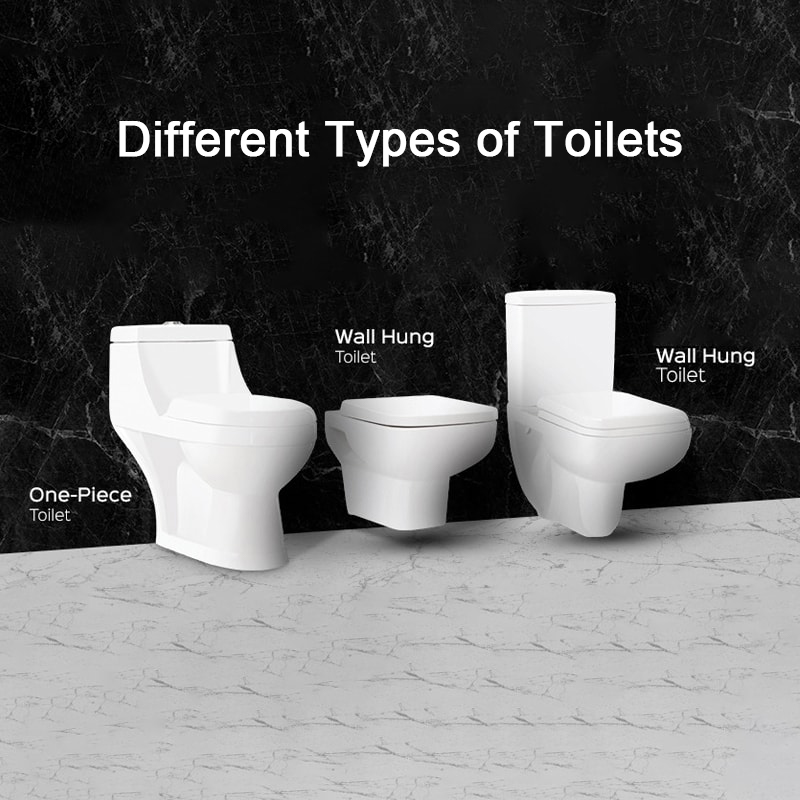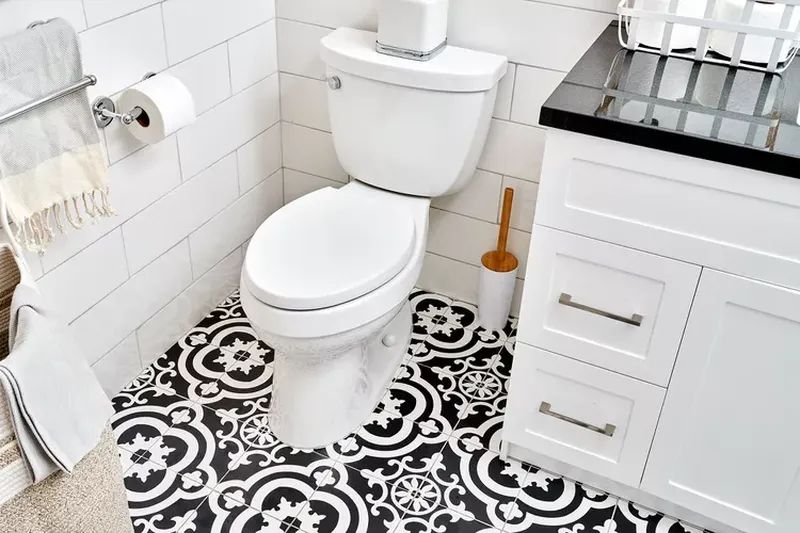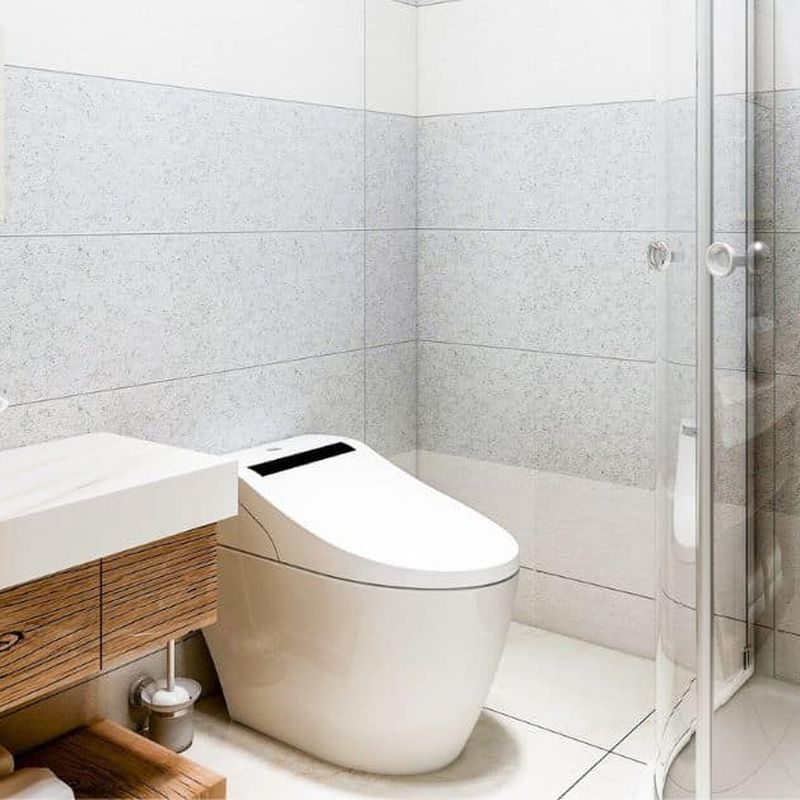 English
English
Jabra Sanitary is a sanitaryware supplier offering toilets, sinks, faucets, bathtubs, etc., at competitive prices. If you're a distributor, wholesaler, or project contractor, get a quote today!
 $23.9 Limited-time Offer
$23.9 Limited-time Offer Consignment Policy
Consignment Policy 20 Years of Experience
20 Years of Experience
When it comes to bathroom remodeling, toilets may not be the most exciting fixture to think about, but choosing the right one is essential.
This guide will explore the diverse types of toilets, covering the most popular styles, mechanisms, and designs so you can make an informed choice for your bathroom upgrade. Whether you're looking for new toilet designs or comparing different kinds of toilets, this guide has you covered.

Table of Contents
Different Types of Toilets
1. Gravity Flush Toilet
2. Pressure-Assisted Toilet
3. Dual-Flush Toilet
4. Double-Cyclone Toilet
5. Waterless Toilet
6. Elongated Toilet Bow
7. Round Toilet Bowl
Common Toilet Styles
1. One-Piece Toilet
2. Two-Piece Toilet
3. Wall Hung Toilet
4. Back to Wall Toilet
5. Rimless Toilet
6. Corner Toilet
7. Short Projection Toilet
Types of Flushing Systems
1. Single-Flush Toilet
2. Double-Flush Toilet
3. Toilet with Flushometer
4. Touchless Flush Toilet
Toilets with Additional Features
1. Bidet Toilet
2. Smart Toilet
3. Eco-Friendly Toilet
4. High-Level Toilet
5 Low-Level Toilet
6. Home Urinal
How to Choose the Right Toilet for Your Bathroom - Factors to Consider
Buy Toilets Wholesale Online for House and Apartment Projects
FAQs
Summary
Different Types of Toilets
There are many different types of toilets available to suit various preferences and requirements.
From gravity flush to pressure-assisted and water-saving dual-flush models, each type of toilet offers distinct benefits in terms of performance, water efficiency, and style, allowing you to select the best option for your bathroom needs.
1. Gravity Flush Toilet
Gravity flush toilets use a simple system where water flows from the tank into the bowl, using gravity to remove waste. They are one of the most common kinds of toilets due to their reliability and straightforward mechanism.

Pros: Simple mechanism, reliable, minimal maintenance, quieter flush.
Cons: Less powerful than pressure-assisted options and may use more water per flush.
Best For: Residential bathrooms that don't require high water pressure.
2. Pressure-Assisted Toilet
Pressure-assisted toilets enhance water flow by using pressurized air within the tank, delivering a more powerful flush. This system is ideal for bathrooms with high traffic demands and is among the different types of toilets suited for large households or commercial spaces.

Pros: Powerful flush, reduces clogging, and highly effective for high-use bathrooms.
Cons: Louder flush, higher initial cost, and may require more maintenance.
Best For Large households, commercial spaces, or bathrooms with high-traffic usage.
3. Dual-Flush Toilet
Dual-flush toilets offer two flush options: a low-flush button for liquid waste and a full-flush button for solid waste, making them more water-efficient. This design is perfect for homeowners looking to save water and is one of the most eco-conscious types of toilets available.

Pros: Saves water, environmentally friendly, and provides flush options for different needs.
Cons: Higher upfront cost and may require more complex repairs.
Best For: Eco-conscious homeowners or areas with water use restrictions.
4. Double-Cyclone Toilet
The double-cyclone toilet utilizes two nozzles to create a powerful centrifugal flush, using less water without sacrificing performance. This innovative design is popular among eco-friendly types of WC and offers a unique mechanism for homeowners focused on water conservation.
Pros: Water-saving, powerful flush, and quieter operation.
Cons: Limited to certain brands, generally higher price point.
Best For Modern homes aiming to balance water conservation and effective flushing power.
5. Waterless Toilet
Waterless toilets, such as composting or dry toilets, do not require a water connection. These types of toilets are designed for eco-friendliness, converting waste to compost or utilizing dry disposal methods.
Pros: Eliminates water usage, is highly sustainable, and practical in remote locations.
Cons: Needs regular maintenance for odor control, and requires ventilation systems.
Best For Off-grid homes, eco-conscious owners, and areas with water scarcity.
6. Elongated Toilet Bow
Elongated toilet bowls are designed with a longer, oval shape that provides added comfort for seated users. This shape has become popular for its ergonomic benefits and is one of the widely preferred toilet bowl styles.

Pros: Comfortable, modern look, widely preferred by adults.
Cons: Takes up more space and is typically more expensive than round bowls.
Best For Bathrooms with ample space or for users prioritizing comfort over compactness.
7. Round Toilet Bowl
Round toilet bowls have a compact, circular shape, making them an ideal choice for smaller bathrooms or powder rooms. This style is commonly seen among different types of wc designed for compact spaces.

Pros: Space-saving, affordable, ideal for compact spaces.
Cons: Less comfortable for extended use compared to elongated bowls.
Best For: Small bathrooms, powder rooms, or budget-conscious renovations.
Common Toilet Styles
Common toilet styles offer a variety of designs to suit different bathroom aesthetics and layouts. From traditional two-piece models to sleek one-piece and wall-hung toilets, each style brings unique functionality and visual appeal. Choosing among these different toilet styles allows you to match your bathroom's look and space needs effectively.
1. One-Piece Toilet
A one-piece toilet has an integrated tank and bowl, creating a seamless and modern look. This type of toilet style is easier to clean and often adds a touch of luxury.

Pros: Sleek design, fewer crevices for dirt, lower maintenance.
Cons: Heavier to install and generally more expensive than two-piece toilets.
Best For Modern bathrooms or users who prefer a low-maintenance toilet with a streamlined design.
2. Two-Piece Toilet
A two-piece toilet is the traditional style where the tank and bowl are separate, connected during installation. This classic design remains popular and widely available in various types of toilets.

Pros: Typically more affordable, easier to repair, parts readily available.
Cons: Harder to clean due to crevices between tank and bowl, more prone to leaks.
Best For: Budget-conscious renovations, traditional or classic bathroom designs.
3. Wall Hung Toilet

Wall-hung toilets are mounted on the wall with a concealed tank, giving them a "floating" look. This design is space-saving and stylish, ideal for modern, minimalist bathrooms, and represents a new trend among different styles of toilets.
Pros: Space-saving, easy to clean under, stylish and contemporary.
Cons: Higher installation costs and specialized maintenance required.
Best For Modern, minimalist bathrooms or bathrooms where space optimization is important.
4. Back to Wall Toilet
Back-to-wall toilets feature a bowl positioned flush against the wall, hiding the plumbing for a cleaner, streamlined look. This type is among the different types of wc that offer an elegant, space-efficient option for contemporary designs.

Pros: Sleek design, hidden plumbing, easy to clean.
Cons: Limited access to plumbing, may require professional installation.
Best For Contemporary bathroom designs and users who prefer a clean, minimal look.
5. Rimless Toilet
Rimless toilets lack the inner rim, allowing for a more thorough cleaning with each flush. This design is increasingly popular among kinds of toilets that emphasize hygiene.

Pros: Easier to clean, more hygienic, modern design.
Cons: Often higher cost, may require specialized cleaning tools.
Best For: Households prioritizing hygiene and modern, minimalist bathroom designs.
6. Corner Toilet
Corner toilets are designed to fit into the corner of a bathroom, maximizing available space and offering a unique layout option. Among different toilet types, this design is especially useful for small bathrooms.
Pros: Space-efficient, ideal for small bathrooms, unique appearance.
Cons: Limited design options, potentially higher cost.
Best For Compact bathrooms, powder rooms, or unique bathroom layouts.
7. Short Projection Toilet
Short projection toilets are designed with a smaller depth, making them ideal for narrow or compact spaces without sacrificing usability. This style is a great option among types of toilets for narrow bathrooms.
Pros: Saves space, retains modern aesthetics, practical for narrow areas.
Cons: May be less comfortable for larger users.
Best For Narrow bathrooms, powder rooms, or compact spaces where every inch counts.
Types of Flushing Systems
The types of flushing systems available today provide options for efficient water usage and powerful flushing performance.
From single-flush to eco-friendly dual-flush systems, these options cater to various water conservation needs and bathroom traffic levels, making it easy to find the right type of toilet for your home.
1. Single-Flush Toilet
The single-flush toilet uses a single, consistent flush strength for both liquid and solid waste. This traditional type of toilet is commonly found in older models and is straightforward to use.
Pros: Simple mechanism, widely available, affordable.
Cons: Less water-efficient compared to dual-flush options.
Best For: Budget-conscious users or areas without strict water usage regulations.
2. Double-Flush Toilet
The double-flush toilet features two flush options: a low-flow flush for liquid waste and a full flush for solid waste, designed to conserve water.
Pros: Water-saving, eco-friendly, customizable flush strength.
Cons: Higher initial cost, slightly more complex repair requirements.
Best For: Homes in areas with water restrictions or for eco-conscious households.
3. Toilet with Flushometer
Flushometer toilets are often found in commercial settings, using a valve to control water flow without a tank. They provide a strong flush and quick refill rate, making them a powerful choice among commode types for high-traffic areas.
Pros: High-powered flush, quick refill, ideal for high-traffic areas.
Cons: Expensive, may not be suitable for all home settings, requires professional installation.
Best For: Commercial restrooms, public spaces, and high-traffic areas.
4. Touchless Flush Toilet
Touchless flush toilets are equipped with motion sensors, allowing users to flush without touching the handle. This enhances hygiene and reduces contact with germs, making it a desirable choice among different toilet styles for modern bathrooms.
Pros: Improved hygiene, modern appeal, convenient.
Cons: More expensive, requires batteries or power, can need specific maintenance.
Best For: Public restrooms, homes prioritizing hygiene, and modern or tech-forward bathroom designs.
Toilets with Additional Features
Toilets with additional features enhance convenience, hygiene, and comfort. Innovations such as bidet functionality, touchless flush, and smart toilet technology transform a simple bathroom fixture into a high-tech, user-friendly experience. These offer options that go beyond basic kinds of toilets.
1. Bidet
A bidet is a bathroom fixture designed to provide a cleansing wash after using the toilet. Typically, it features a water spray that helps clean the genital and anal areas.
Bidets can either be standalone units or be integrated into a toilet seat for a more modern, compact design. Some models include adjustable water pressure, temperature controls, and even air-drying options.
Pros: Promotes hygiene, reduces toilet paper usage, user-friendly and comfortable.
Cons: Higher upfront cost, may need additional plumbing installation. And add to overall water consumption. For standalone bidets, additional bathroom space is necessary.
Best For: Households looking to enhance hygiene and comfort, and bathrooms with space for additional plumbing.
2. Smart Toilet
Smart toilets integrate advanced technology, such as heated seats, self-cleaning features, automatic lid opening, and even built-in speakers. They represent the cutting-edge among new toilet designs, offering luxury and convenience.

Pros: Luxurious and comfortable, convenient, offers numerous customizable features.
Cons: Expensive, requires electricity, can need specialized repairs.
Best For: High-end homes, tech-savvy users, and those looking for luxury and convenience in the bathroom.
3. Eco-Friendly Toilet
Eco-friendly or low-flow toilets are designed to use less water per flush, meeting environmental standards and reducing overall water consumption. These types of wc are especially suitable for eco-conscious homeowners.

Pros: Saves water, environmentally friendly, often meets regulatory standards for water conservation.
Cons: May have a weaker flush, potentially higher initial cost.
Best For: Eco-conscious homeowners and areas with water use restrictions.
4. High-Level Toilet
High-level toilets feature a classic design with the tank positioned high on the wall, connected to the bowl by a long pipe. They offer a vintage aesthetic with a powerful gravity-assisted flush, perfect for traditional kinds of toilet designs.
Pros: Unique vintage look, strong flush, enhances classic bathroom styles.
Cons: Requires adequate wall space, limited to traditional bathroom designs.
Best For: Traditional and vintage bathroom designs, homeowners seeking a classic look.
5 Low-Level Toilet
Low-level toilets have the tank positioned closer to the bowl with a short connecting pipe. This style is slightly more compact than high-level toilets but retains a classic look.
Pros: Compact size, vintage appeal, suitable for retro styles.
Cons: Limited modern appeal, requires plumbing adjustments.
Best For: Retro-style bathrooms or homes with a vintage aesthetic.
6. Home Urinal
Home urinals are compact fixtures often found in commercial settings but can also be installed in residential bathrooms for added convenience and water savings. They represent a unique option among commode types, ideal for large households.
Pros: Saves water, convenient for multi-person households, compact size.
Cons: Requires additional plumbing, may increase cleaning requirements.
Best For: Large households, eco-conscious homeowners, and bathrooms with extra space.
How to Choose the Right Toilet for Your Bathroom - Factors to Consider
Choosing the right toilet involves considering factors like bathroom space, toilet bowl shapes, water efficiency, and flush types. By focusing on these aspects, you can find a toilet style and flushing mechanism that suits both your aesthetic preferences and practical needs.
Room Space and Installation Type
Bathroom size and layout play a crucial role in selecting the right toilet. For smaller spaces, compact or corner toilets may be ideal, while spacious bathrooms can accommodate larger styles like elongated or one-piece toilets.
Considerations: Assess available space, preferred style (e.g., wall-mounted, one-piece, or two-piece), and any specific needs for compact or standard toilets.
Toilet Flush Systems
Flush systems vary greatly and can impact both water usage and flushing power. Single-flush systems are straightforward, while dual-flush and eco-friendly options conserve water. Pressure-assisted or flushometer systems may be necessary for high-traffic bathrooms.
Considerations: Choose based on water conservation goals, bathroom usage, and preferences for noise and flush strength.
Toilet Bowl Shapes
Toilet bowls come in elongated and round shapes. Elongated bowls offer more comfort but take up more space, while round bowls are compact and ideal for smaller bathrooms.
Considerations: Elongated bowls are preferred for comfort, while round bowls are better suited for limited spaces.
Toilet Height
Toilet height impacts comfort, particularly for adults and seniors. Standard-height toilets are around 15 inches from the floor, while chair-height toilets are 17 to 19 inches, providing easier seating and standing for those with mobility issues. <Learn standard height vs comfort height toilet>
Considerations: Standard height is suitable for most users, while chair height can offer added comfort for taller individuals or those with joint concerns.
Water Usage
Federal regulations require that modern toilets use no more than 1.6 gallons per flush. High-efficiency toilets (HETs) use even less, which can result in significant water savings over time.
Considerations: Eco-conscious homeowners may prefer HETs, dual-flush, or low-flow toilets to minimize water usage.
Outlet Trapway Types
Trapways can be exposed, concealed, or fully concealed, impacting ease of cleaning and aesthetics. Fully concealed trapways create a streamlined look, while exposed trapways allow for easier access in case of repairs.
Considerations: Concealed trapways enhance visual appeal, but exposed trapways may be more practical in terms of maintenance.
Cost and Budget
Toilet costs vary widely depending on style, features, and brand. While budget toilets cover basic needs, premium models may offer advanced functions and higher-quality materials.
Considerations: Determine a budget and balance it with the features and durability required for your household's needs.
Buy Toilets Wholesale Online for House and Apartment Projects
Buying toilets online, especially from wholesale suppliers and manufacturers like Jabra Sanitary, lets you explore an extensive selection of styles, features, and price points—all from the comfort of home. Wholesale toilet suppliers often provide detailed specifications, customer reviews, and options for professional installation, making it easy to find the right fit.
Tips for Buying Toilets Wholesale from Manufacturers:
-
Read Customer Reviews: Reviews offer valuable insights on durability, installation ease, and overall satisfaction.
-
Verify Product Specifications: Check dimensions, flush mechanisms, and water efficiency ratings to ensure each model meets your project requirements.
-
Consider Professional Installation Options: Many wholesale manufacturers and suppliers, like Jabra Sanitary, offer or recommend licensed professionals to help with installation.
Shopping for toilets directly from manufacturers or wholesale suppliers allows you to compare prices and features across brands more easily, ensuring the best choice for your house or apartment project at a competitive price.
FAQs
Why are American toilets different from the UK?
American toilets typically use a tank system with either a gravity or pressure-assisted flush, while many UK toilets have siphon flush systems. American toilets often have a round or elongated bowl, while UK designs may include high-level or low-level flush designs for a classic look.
What is the latest innovation in toilets?
Smart toilets are one of the latest innovations, featuring technology like heated seats, bidet functions, automatic flushing, and even app connectivity. Eco-friendly toilets are also gaining popularity for their low water usage.
Which toilet is most popular today?
Dual-flush and eco-friendly toilets are highly popular due to their water-saving benefits. In terms of style, one-piece and wall-hung toilets are in demand for their sleek, modern appearance.
What is the most common toilet bowl shape?
The elongated toilet bowl shape is the most common, as it offers added comfort for users. However, round bowls are also popular in smaller bathrooms where space is limited.
What is the difference between expensive and cheap toilets?
Expensive toilets generally include advanced features, higher-quality materials, and a more polished design. They may offer additional comfort, water efficiency, and durability. Cheaper toilets typically cover basic functionality but may lack additional features and may require more frequent repairs.
Summary
Toilets come in a wide variety of types, styles, and mechanisms to suit every bathroom design and functionality need. From gravity flush to smart and eco-friendly toilets, the options available cater to different space, usage, and aesthetic preferences.

When choosing the right toilet, consider factors like room space, flush systems, bowl shape, and water usage to find the best fit for your bathroom. Whether you're upgrading your home's fixtures or outfitting a new space, this guide can help you make a well-informed decision.






















